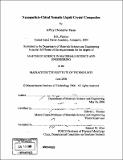Nanoparticle-chiral nematic liquid crystal composites
Author(s)
Payne, Jeffrey C. (Jeffrey Christopher), 1981-
DownloadFull printable version (11.66Mb)
Other Contributors
Massachusetts Institute of Technology. Dept. of Materials Science and Engineering.
Advisor
Edwin L. Thomas.
Terms of use
Metadata
Show full item recordAbstract
The advancement of the fabrication of a one-dimensional photonic crystal without time-reversal and space-inversion symmetries was pursued. Theoretical studies predict that such a system would exhibit unusual optical properties, including indirect photonic band gaps and backward wave propagating eigenmodes. Such a system can be created experimentally by combing magnetooptical nanoparticles with a chiral nematic liquid crystal. The fabrication of this material system was advanced through two distinct phases of research. The first phase seeks to produce magnetooptical yttrium iron garnet (YIG) nanoparticles with an average diameter on the order of 15-50 nm. It was determined that a commercially available yttrium iron oxide nanopowder (purchased from Sigma-Aldrich Corporation) exhibited YIG and orthorhombic yttrium iron oxide (YFeO3) phases after being calcined at 800 °C for two hours. These nanoparticles were slightly smaller than desired, having diameters on the order of 10-20 nm. Direct nanoparticle synthesis via coprecipitation in microemulsions produced superior results, resulting in a pure YIG material with diameters on the order of 30-50 nm. (cont.) The second phase examines the manner in which nanoparticles co-assemble with a chiral nematic liquid crystal. It was determined that the addition of nanoparticles to a 5CB-COC system disrupts the system's helical structure. This disruption lowers the system's phase transition temperatures and inhibits the system's ability to form reflectivity peaks.
Description
Thesis (S.M.)--Massachusetts Institute of Technology, Dept. of Materials Science and Engineering, 2006. Includes bibliographical references (leaves 76-79).
Date issued
2006Department
Massachusetts Institute of Technology. Department of Materials Science and EngineeringPublisher
Massachusetts Institute of Technology
Keywords
Materials Science and Engineering.